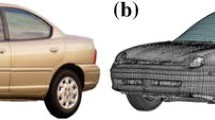Abstract
Design optimization is presented for the crashworthiness improvement of an automotive body structure. The optimization objective was to improve automotive crashworthiness conditions according to the defined criterion (occupant chest deceleration) during a full frontal impact. The controllable factors used in this study consisted of six internal parts of the vehicle’s frontal structure in a condition that their thickness was the “design parameter”. First using the Taguchi method, this study analyzed the optimum conditions in discontinuous design area and impact factors and their optimal levels of design objectives were obtained by analyzing the experimental results. Next to model a precise understanding of the explicit mathematical input–output relationship, fuzzy logic is utilized which make use of full factorial design set of experimental test cases resulted from Taguchi predicting formulations. Interestingly, the optimum conditions for automotive crashworthiness occurred with 2.72 % improvement in the defined crashworthiness criterion in comparison with the baseline design while selected structural parts experienced mass reduction by 8.23 %.










Similar content being viewed by others
References
Abbasi M, Kazemi R, Ghafari Nazari A (2011) Using a parametric method for investigating automotive crashworthiness. Int J Automot Eng 1(3):165–172
Agatonovic-Kustrin S, Wu V, Rades T, Saville D, Tucker I (2000) Ranitidine hydrochloride X-ray assay using a neural network. J Pharm Biomed Anal 22(6):985–992
Avalle M, Chiandussi G, Belingardi G (2002) Design optimization by response surface methodology: application to crashworthiness design of vehicle structures. Struct Multidiscip Optim 24(4):325–332
Baseri H, Rabiee S, Moztarzadeh F, Solati-Hashjin M (2010) Mechanical strength and setting times estimation of hydroxyapatite cement by using neural network. Mater Des 31(5):2585–2591
Çelik S, Tan Ö (2005) Determination of preconsolidation pressure with artificial neural network. Civ Eng Environ Syst 22(4):217–231
Deb A, Mahendrakumar M, Chavan C, Karve J, Blankenburg D, Storen S (2004) Design of an aluminium-based vehicle platform for front impact safety. Int J Impact Eng 30(8–9):1055–1079
Duddeck F (2008) Multidisciplinary optimization of car bodies. Struct Multidiscip Optim 35(4):375–389
Eskandarian A, Marzougui D, Bedewi NE (1997) Finite element model and validation of a surrogate crash test vehicle for impacts with roadside objects. Int J Crashworthiness 2(3):239–258
Etman L, Adriaens J, Van Slagmaat M, Schoofs A (1996) Crash worthiness design optimization using multipoint sequential linear programming. Struct Multidiscip Optim 12(4):222–228
Fang H, Rais-Rohani M, Liu Z, Horstemeyer MF (2005) A comparative study of metamodeling methods for multiobjective crashworthiness optimization. Comput Struct 83(25–26):2121–2136
Huang M (2002) Vehicle crash mechanics. CRC
Jang JSR (1993) ANFIS: adaptive-network-based fuzzy inference system. IEEE Trans Syst Man Cybern 23(3):665–685
Kang G, Lee W, Sugeno M (1998) Design of TSK fuzzy controller based on TSK fuzzy model using pole placement. IEEE 241:246–251
Kodiyalam S, Yang R, Gu L, Tho CH (2004) Multidisciplinary design optimization of a vehicle system in a scalable, high performance computing environment. Struct Multidiscip Optim 26(3):256–263
Kurtaran H, Eskandarian A, Marzougui D, Bedewi N (2002) Crashworthiness design optimization using successive response surface approximations. Comput Mech 29(4):409–421
Mamdani EH (1976) Advances in the linguistic synthesis of fuzzy controllers. Int J Man–Mach Stud 8(6):669–678
Mamdani EH, Assilian S (1975) An experiment in linguistic synthesis with a fuzzy logic controller. Int J Man–Machi Stud 7(1):1–13
Marklund PO, Nilsson L (2001) Optimization of a car body component subjected to side impact. Struct Multidiscip Optim 21(5):383–392
Pan F, Zhu P (2011) Design optimisation of vehicle roof structures: benefits of using multiple surrogates. Int J Crashworthiness 16(1):85–95
Roy R (1990) A primer on the Taguchi method, competitive manufacturing series. New York, pp 7–80
Shi L, Yang R, Zhu P (2012) A method for selecting surrogate models in crashworthiness optimization. Struct Multidiscip Optim 46(2):159–170
Sinha K (2007) Reliability-based multiobjective optimization for automotive crashworthiness and occupant safety. Struct Multidiscip Optim 33(3):255–268
Sobieszczanski-Sobieski J, Kodiyalam S, Yang R (2001) Optimization of car body under constraints of noise, vibration, and harshness (NVH), and crash. Struct Multidiscip Optim 22(4):295–306
Stander N, Roux W, Giger M, Redhe M, Fedorova N, Haarhoff J (2004) A comparison of metamodeling techniques for crashworthiness optimization. In: 10 th AIAA/ISSMO multidisciplinary analysis and optimization conference
Taguchi G, Organization AP (1986) Introduction to quality engineering: designing quality into products and processes. The Organization Tokyo
Won JM, Park SY, Lee JS (2002) Parameter conditions for monotonic Takagi–Sugeno–Kang fuzzy system. Fuzzy Sets Syst 132(2):135–146
Yang RJ, Akkerman A, Anderson DF, Faruque OM, Gu L (2000) Robustness optimization for vehicular crash simulations. Comput Sci Eng 2(6):8–13
Yang R, Wang N, Tho C, Bobineau J, Wang B (2005) Metamodeling development for vehicle frontal impact simulation. J Mech Des 127(5):1014–1020
Yingjie L, Baoshu W (2005) Study on the control course of ANFIS based aircraft auto-landing. J Syst Eng Electron 16(3):583–587
Youn BD, Choi K, Yang RJ, Gu L (2004) Reliability-based design optimization for crashworthiness of vehicle side impact. Struct Multidiscip Optim 26(3):272–283
Zhu P, Zhang Y, Chen G (2009) Metamodel-based lightweight design of an automotive front-body structure using robust optimization. Proc Inst Mech Eng Part D J Automob Eng 223(9):1133–1147
Zou T, Mahadevan S (2006) A direct decoupling approach for efficient reliability-based design optimization. Struct Multidiscip Optim 31(3):190–200
Acknowledgments
The authors would like to appreciate to Dhafer Marzougui, Pradeep Mohan, Vinay Nagabhushana and Steve Kan from FHWA/NHTSA National Crash Analysis Center (NCAC) at the George Washington University for providing vehicle FEM model.
Author information
Authors and Affiliations
Corresponding author
Rights and permissions
About this article
Cite this article
Abbasi, M., Ghafari-Nazari, A., Reddy, S. et al. A new approach for optimizing automotive crashworthiness: concurrent usage of ANFIS and Taguchi method. Struct Multidisc Optim 49, 485–499 (2014). https://doi.org/10.1007/s00158-013-0986-6
Received:
Revised:
Accepted:
Published:
Issue Date:
DOI: https://doi.org/10.1007/s00158-013-0986-6




